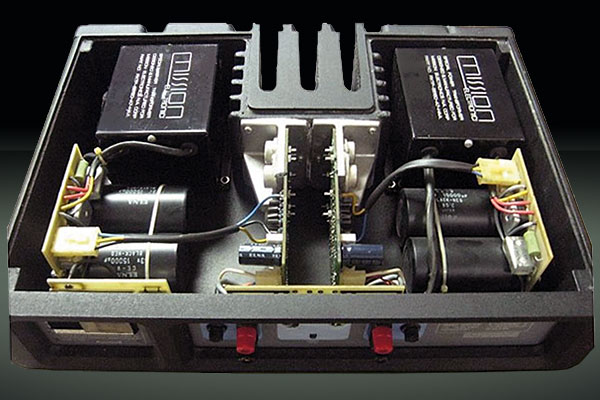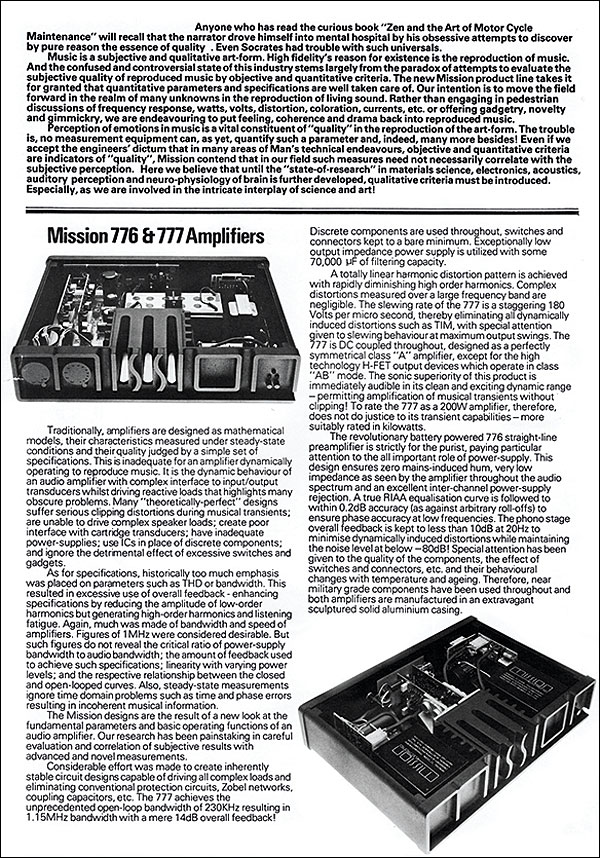Mission 776/777 combo Page 2
Driven Hard
At full power, 8ohm, the two-tone 19/20kHz intermodulation measured –73dB for the difference tone (the sum level was similar) improving to –81dB (0.009%) at 0dBW, all fine results. The 777 was, however, not so happy with noise intermodulation: at the clipping threshold the 1kHz 1⁄3 octave intermodulation was –40dB, similar on both 8ohm and 8ohm+2µF loads. At +10dB input, close to the continuous RMS equivalent clipping point, a typical –33dB (2.2%) was recorded, this is not unusual, and when the noise input was reduced so that the peak levels were 10dB below the clip point, the difference intermodulation improved to better than –77dB for both the 8ohm+2µF and 8ohm only loads.
The result at peak levels suggests some dynamic asymmetry on this taxing high-frequency signal, and perhaps this is associated with the mild extra 'bite' noted on the listening tests close to full power. Driven hard at 100Hz, the square wave response was textbook, showing no supply interaction and a flat top, confirming the response down to DC. The 1kHz square wave response was no different, and with the 8ohm+2µF load at 1kHz, there is the usual 40% or so overshoot and quickly damped ringing, the latter estimated at a high 70kHz.

This output stage 'speed' explains why the rise in response at 20kHz with 2µF loading was so small at the 0dBW level, namely 0.1dB. Something was discovered here – a response lift at a 13dBW equivalent level with 8ohm+2µF, 20kHz, which measured 0.33dB. This suggests that the effective bandwidth and high-frequency phase response possess some variation with power level.
Signal/noise ratios were fine at 80dB relative to 0dBW, unweighted, and were 85dB excluding hum. The noise corresponded to 170µV (ex. hum) while the input sensitivity for 20dBW or 100W was nominally 1V. Channel separation was not quite as good as expected at high frequencies in view of the double mono construction, but it was fine at 63dB, 20kHz, improving to better than 100dB at low frequencies.
Conclusion 777
Notwithstanding a minor reservation concerning the upper frequency range sound quality, in all other respects the 777 delivered an exemplary performance. It bears close comparison with some of the finest and most costly designs I have ever tested and is capable of considerable power delivery into a wide range of loadings. The 777 wins a place as a reference design and will undoubtedly represent good value for money.
Mission 776
Housed in the same generous casing as the power amp, the 776 preamp consists physically more of power supply than of amplifier. Only the lefthand portion roughly delineated by the two rotary control knobs is occupied by the real circuitry, each channel allotted a single small printed circuit card populated with components of superlative quality.
At present, the unit only has facilities for MM cartridges but an MC version of the preamp card is underway. In the meantime, the unit was used with step-up devices. The controls comprise 'mono', tape monitor, balance and input selection, the latter allowing selection from tuner, tape auxiliary, and pick-up sources. It also has two on/off buttons. The lefthand of the pair switches the preamp electronics but is interlocked with the righthand one, which controls the mains supply.

This brings us to the power supply, which consists of a large 25V sealed lead/acid accumulator. During use the mains supply is disengaged, but when the 'mains/charge' button is pressed the preamp switches off and recharges the internal battery, ready for an average of 25 hours' use thereafter. It may be left on trickle charge indefinitely.
The objective was to make the preamp hum-free in normal use, yet incorporate a high quality, low noise, low impedance power supply. The battery is further decoupled by capacitors – one massive 10,000µF followed by 2200µF per channel, the latter themselves decoupled by 4.7µF polyester capacitors.
The design is conservative in some respects, eg, the single-rail supply, the preamp consisting of just two stages, namely a 34dB gain phono amplifier/equaliser (plus the selector/volume control) and a 20dB line amp. This follows the volume control using just three transistors in a low feedback configuration, the third transistor operating as an active load or constant current source for the second transistor of the feedback pair. The output is AC-coupled via a 4.7µF capacitor, this fed from a low output impedance of 250ohm, capable of driving long cables.
Meanwhile, the volume control is of the stepped variety and has a sensible range of ratios. The balance control is also stepped, covering a few dB and appearing in the feedback loop of the output stage, whereby possible spurious effects are reduced by negative feedback. The phono equaliser uses a differential input pair with the RIAA equalisation network fed to the second input transistor base.
The output section of the equaliser has an active load as the in the case of the output amplifier, and this section is again AC-coupled, both in and out. These coupling capacitors are themselves bypassed with smaller value different type components to, as Mission puts it, 'reduce the sonic signature of the individual components'.
The input has some radio interference suppression in the form of a small high-frequency network, and a subsonic filter is present, operating at a low enough frequency not to upset the RIAA equalisation. The input values suggest a –3dB point at 10Hz, which is a worthwhile compromise.
![]() Sound Quality
Sound Quality
Having previously checked out the 777 with a range of preamps and made detailed and favourable comparisons with other reputable models, it was with some relief to find that the 776 preamp proved to be fully worthy of the 777.
Only by using the finest quality source signals can the potential of better equipment be recognised, and substitution of inferior step-up devices or cartridges, will also impair system quality. It was also interesting to note that some of the benefits of the 776 were still apparent using records of less than first rate quality – the 776's high clarity, general feeling of precision and detail plus good treble transparency were still worthwhile with a noticeable reduction in the aggravating effects of hiss, some surface noise and record 'ticks'.
When compared with other good quality preamps, the 776 proved to be very neutral, with a treble register noticeably free of the odd effects encountered with other designs. For example, a hazy or slightly fizzy overlay, this even tending to exaggerated vocal sibilance with the poorest examples.
The stereo depth, was exceptionally good on the 776, particularly in the midband, and it clearly illustrated the false modulation of depth by signal dynamic changes apparent with another high-technology preamplifier. The performance in the bass did not seem to compromise the high standard of the 777, and we must hope that the MC version of the preamp can match or perhaps even improve on the MM standard.
Lab Report
Assuming all else to be correct, the most important single parameter affecting preamp sound is the accuracy of the RIAA equalisation. The Mission 776 did have pretty accurate equalisation, and the specified 30Hz to 15kHz range was followed within ±0.1dB.

Looking at the shelving effects the overall response showed a mild +0.1 to 0.17dB shelf lift in the treble, in my view not significant in the case of sequential rather than rapid A/B listening. The equalisation remained effective to beyond 100kHz, helping to keep ultrasonic rubbish from the pick-up cartridge out of the following stages.
Subsonic roll-off was controlled such that the response was barely 0.6dB down at 20Hz falling to –3dB, 10Hz. Via auxiliary the response was –0.2dB at 20Hz and –0.4dB/20kHz, falling to –6dB/120kHz.
An anomaly was noted on the volume control at very low settings, when high-level inputs were used. The high frequencies became excessively lifted on the last few settings to zero: for example, at '3 notches or clicks' the 20kHz point was 4dB too high, but by '5 notches' everything was fine again. Some breakthrough was also noticed from the auxiliary input to the pick-up.
Pick-up impedance (MM) was specified at 260pF in parallel with 47kohms which, when taking into account the typical capacitance of 100pF, leads to a minimum total capacitance of 360pF.
As a result of the battery power supply, hum was absent, and the unweighted pick-up S/N ratio was 70dB, including low frequency noise, or 78dB, 400Hz-20kHz (–79dB both 'A' and CCIR weighted). The lab results showed minor failings as regards high-frequency channel isolation, input crosstalk and very low volume frequency response, but otherwise the Mission 776 preamp was beyond reproach.
Conclusion 776
When it comes to sound quality this is undoubtedly one of the best preamps I have tested over the past few years, and despite the limited facilities I repeatedly returned to it for a definitive view of the sound reproduction available.
Its sonic performance exceeds that of a number of more costly designs, and in partnership with the 777 I can only reiterate their exceptional sonic quality. I have no hesitation in recommending this design, and look forward to reporting on the MC boards.
























































